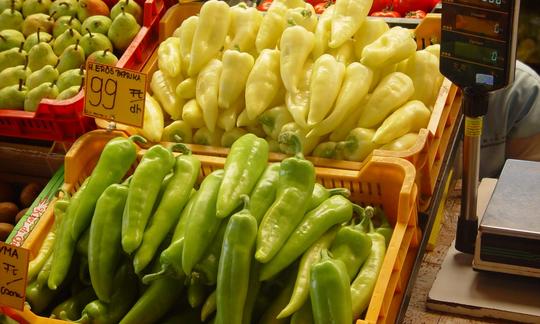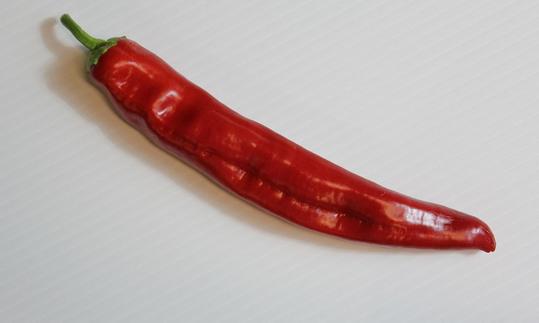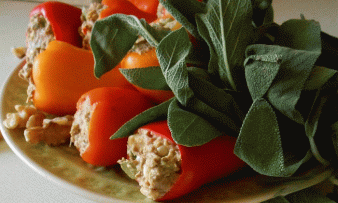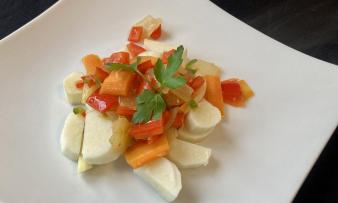Table of contents
Pointed peppers ( raw, organic?), belonging to the genus pepper ( Capsicum annuum, also Spanish pepper), are part of the nightshade family (Solanaceae) and are characterized by their pointed shape and their sweet to strong-spicy taste.
Using pointed peppers in the kitchen:
Whether in Asian wok dishes or Italian pasta sauces, pointed peppers can be used in many different ways in the kitchen. They are particularly suitable for stuffing with vegetables (tomatoes, mushrooms, beans, etc.) or tofu and for gratinating with vegan cheese. They also taste good grilled or fried in a pan. A combination of pointed peppers and grain products such as couscous, bulgur, corn semolina or millet is tasty and filling. Rice also goes well with it. The pods can be pickled in oil or vinegar to make antipasti. In a spicy pepper soup or as a dip, the peppers provide a fruity, aromatic taste.
If you want to peel pointed peppers, you can bake them in the oven for a few minutes, then the skin can be easily peeled off.
Can you eat pointed peppers raw? Raw pointed peppers are a delicious and healthy snack and can be used in salads, for example.
A mild paprika powder made from pointed peppers can be used to season dishes. You can find out more about using paprika powder in the kitchen and how to make it yourself in the article Paprika powder, sweet.
Vegan recipe for Asian carrot and pepper soup:
Ingredients (for 4 people): 1 kg carrots, ¾ l vegetable stock (vegan), 300 ml water, 2 red pointed peppers (organic), 2 onions, 5 tbsp soy sauce, 3 tbsp lemon juice, a little rapeseed oil for frying, 1 tsp red curry paste, salt, green pepper.
Preparation: Wash the peppers and carrots. Peel the onions and remove the seeds from the peppers. Cut the vegetables into 1-2 cm pieces. Heat the oil in a pan. Add the peppers, carrots and onions and fry for about 2 minutes. Then stir in the curry paste. Deglaze the vegetables with 2 tablespoons of lemon juice and 750 ml of vegetable stock. Let the soup simmer for 15-20 minutes. Once the carrots are soft, puree the vegetables finely with a hand blender. Gradually add about 300 ml of water until the soup has reached the desired consistency. Bring everything to the boil again briefly and season the soup with the soy sauce, salt, pepper and a little lemon juice. Serve the vegan carrot and pepper soup with fresh bread if desired.
Vegan recipes with pointed peppers can be found under the note: " Recipes that have the most of this ingredient ".
| Not only vegans or vegetarians should read this: Vegans often eat unhealthily. Avoidable nutritional errors. |
Shopping - where to buy pointed peppers?
Pointed peppers are available raw all year round in supermarkets and major retailers such as Coop, Migros, Spar, Aldi, Lidl, Rewe, Edeka, Hofer, Denner and Volg. The peppers are in season in Central Europe from July to October. For the rest of the year, pointed peppers are imported. Organic pointed peppers can be bought in organic shops and organic supermarkets ( Denn's Biomarkt and Alnatura). Some major retailers also offer raw organic pointed peppers.
Fresh peppers (raw food) can be recognized by their bright color, plump and shiny surface and fresh, green stem. If the pointed peppers show discoloration or dull, glassy spots, the cause may be the beginning of rot.
Storage of pointed peppers:
Raw pointed peppers should be stored at 7-8 °C, then they will last for about 1 week. 1 The vegetable compartment of the refrigerator is suitable for short storage periods. Pointed peppers can be kept at room temperature for 2-3 days. Cooked peppers will last for 3-5 days in the refrigerator.
Ingredients - Pointed peppers Nutritional values - Calories:
100 g of raw pointed peppers (organic) contain 37 kcal. The peppers have a water content of around 87%. With 1 g fat and 1 g protein per 100 g, pointed peppers are very low in fat and protein. The carbohydrate content is also quite low at 10 g/100g. The 3.6 g/100g of fiber contained covers 14.4% of the daily requirement. 2
Do pointed peppers contain vitamins? The amount of vitamin C (ascorbic acid) in 100 g of pointed peppers covers around 175% of the daily requirement. The content of 140 mg/100g can be compared with that of red chili peppers (144 mg/100g). Green chili peppers (242.5 mg/100g) and yellow bell peppers (184 mg/100g) contain a lot of the vitamin. 2
The amount of vitamin A, as RAE (retinol equivalent), accounts for around 44% of the daily requirement when consuming 100 g of pointed peppers. The content of 354 µg/100g can be compared with lamb's lettuce (raw) and garden cress (raw). Chili flakes (1,324 µg/100g) or sun-dried chili peppers (1,324 µg/100g) contain a lot of the vitamin. 2
Vitamin E is found in pointed peppers at 2.9 mg/100g. This value is similar to that of sun-dried chili peppers (3.1 mg/100g). The top vitamin E content is found in spice powders such as chili powder at 38 mg/100g. 2
You can find all the nutritional values and ingredients of pointed peppers, the coverage of the daily requirement and comparison values with other ingredients in our nutrient tables. In the article Nutrients explained you will get a detailed insight into the topic.
Health aspects - effects of pointed peppers:
Pointed peppers have a very high vitamin C content (ascorbic acid) and contain 140 mg/100g, almost three times as much vitamin C as lemons (51 mg/100g). 2 With the help of vitamin C, the body can convert copper into usable forms for enzymes. Ascorbic acid acts as a radical scavenger, protects folic acid, vitamin E and LDL particles in the blood from oxidation and promotes the absorption of iron from plant-based foods. 3 The vitamin is said to prevent heart attacks and promote blood circulation. The riper the pepper, the higher the vitamin C content. 4
The vegetable is also characterized by secondary plant substances such as carotenoids, flavonoids and phenols. In red peppers in particular, the bioactive compounds have possible anti-Alzheimer properties and could have a preventive effect. 5 The secondary plant substance capsaicin is responsible for the spiciness of the fruit. It is only present in small amounts in pointed peppers. Small amounts of capsaicin stimulate the appetite and aid digestion. 6
The high amount of antioxidants contained in red peppers, such as the coloring agent capsanthin, beta-carotene or the carotenoid lycopene, neutralize free radicals and reduce oxidative stress. 5,7 Peppers have an anti-inflammatory and gastric juice stimulating effect and can help with digestive disorders. They have a mild laxative effect and can counteract flatulence. Regular consumption of peppers is also said to counteract colon cancer, as vitamin C, vitamin A and the antioxidants they contain protect body cells from changes caused by cancer pathogens. 6
Compared to other peppers, pointed peppers have thinner walls and a noticeably finer skin, making the fruit more digestible and easier to digest.
Dangers - Intolerances - Side effects:
Pointed peppers belong to the nightshade family. These occasionally trigger allergic reactions. In the case of the so-called nightshade allergy, hives and swelling can occur in the face, mouth and throat. A nightshade intolerance, which leads to flatulence and cramps, can also occur. 10
People who suffer from intolerance to herb pollen (e.g. mugwort) could also have an allergic reaction to red bell peppers (cross allergy; allergy to allergens with a similar/identical structure). 8,9 Symptoms of an allergic reaction include a burning sensation in the mouth, swelling of the tongue and numbness of the lips, and even swelling in the larynx area. 9
Use as a medicinal plant:
The active ingredient capsaicin contained in peppers is used in medicine for plasters and ointments against nerve pain and muscle problems. 11
The Scoville value of pointed peppers, which indicates the degree of spiciness, is rather low because they contain only small amounts of capsaicin compared to other varieties. Pointed peppers are therefore primarily used in cooking rather than medicine. You can find more information about the Scoville scale for ingredients with higher values such as chili peppers, green or jalapeños.
Occurrence - origin - ecology:
The pepper plant originally comes from Central and South America. It is a descendant of the wild plant Chiltepin (Tepin, Chiltepin, Capsicum annuum var. glabriusculum), which is also known as the "mother of all chilies". After Columbus brought the pepper plant to Europe in the 15th century, peppers were initially only grown for decoration. Over time, they were increasingly used as a spice and finally as a vegetable in European cuisine after the first mild varieties of sweet pepper were successfully bred in the 1950s. 12,18
Today, pointed peppers are grown in subtropical and temperate zones all over the world, including China, Mexico, the USA, and countries in the Balkans and the Mediterranean. In slightly cooler, central European countries, peppers ripen in greenhouses.
Growing the pointed pepper variety "Corno di Toro":
"Corno di Toro", in German "red bull's horn", is a popular pointed pepper variety from Italy. The sweet-aromatic, slightly spicy-tasting pointed pepper with its curved shape is reminiscent of a bull's horn. The crisp and thick-fleshed peppers can be grown in the home garden. "Corno di Toro" is an annual plant that grows both in the greenhouse and outdoors. Sowing takes place from mid-January to the end of February at a germination temperature of 24-30 °C and high humidity. As soon as three to four leaves are visible, the plants can be pricked out, i.e. the young plants, which initially germinate together in seed trays, are transplanted into individual pots. Sufficient sunlight, warmth, fertilizing with nitrogen-rich fertilizer and regular watering are essential for the plant to thrive. The flowering period is from June to September. "Corno di Toro" can be harvested between August and October. 13
Ecological aspects:
Pointed peppers from conventional cultivation are often heavily contaminated with residues due to the high use of pesticides. Peppers from Thailand, Vietnam, Turkey, Spain and Morocco are particularly affected. Buying organic peppers is therefore worthwhile, because the use of chemical-synthetic additives or pesticides is not permitted in organic pepper cultivation. 14
General information:
Pointed peppers belong to the vegetable peppers and, like chili peppers, belong to the nightshade family (Solanaceae). Botanically speaking, raw peppers are berries.
The nutrient-rich pointed peppers are characterized above all by their long, narrow and pointed pods. They are available in white, green, yellow and red. The color of the peppers is an indication of the ripeness of the fruit. Green peppers (raw) are still unripe and turn yellow, orange or red as they ripen. There are a number of different types of pointed peppers. In the following section you will find a small selection of different types of pointed peppers.
- A well-known pointed pepper is the "Red Augsburger". This robust pepper variety is very popular in organic farming, as the yields are usually quite high even in the open air. Because it has thin walls, the "Red Augsburger" is ideal for drying.
- The "Agio" variety is a Hungarian wax pepper and is available in yellow-green, orange and red. It can be up to 14 cm long. The name wax pepper comes from the fact that the fruits have a waxy color when unripe.
- "Zlata", also a Hungarian wax pepper, is available in a whitish yellow, orange or red. It is thick-walled, about 12 cm long and weighs about 115 g.
- The bullhorn peppers are among the larger pointed pepper varieties. They have thick walls and are slightly curved like the horn of a bull.
- The red "Atris" belongs to the bullhorn peppers and is 19-22 cm long with a diameter of 5-6 cm.
- The bullhorn pepper "Partner" is a yellow pepper that is about 19 cm long. 15
- The "Leutschauer Schotenpfeffer" is a type of pointed pepper with a slight sweetness and spiciness. Due to its thin fruit walls, it is ideal for drying, stuffing, cooking or pickling. 19
Alternative names:
Pointed peppers are known in English as sweet pointed peppers (plural: sweet pointed peppers), while red pointed peppers are also known as red pointed peppers or pointed red peppers. The spelling "Spitz Paprika" is not correct.
Keywords for use:
Carotenoids such as the orange-red dye capsanthin E 160c (capsorubin), which is responsible for the color of peppers, are used as natural coloring agents in foods. 16 Foods that are colored with capsanthin include dressings, sauces, soups and sweets. Capsanthin E160c is also used to color medicines and to make cosmetics. 17
Literature - Sources:
Bibliography - 19 Sources
| 1. | Böttcher H. Frischhaltung und Lagerung von Gemüse. Ulmer: Stuttgart. 1996. |
| 2. | USDA United States Department of Agriculture. |
| 3. | Du J, Cullen J J, Buettner G R. Ascorbic acid: chemistry, biology and the treatment of cancer. Biochim Biophys Acta. 2012;1826(2):443–57. |
| 4. | Marín A, Ferreres F, Tomás-Barberán FA, Gil MI. Characterization and quantitation of antioxidant constituents of sweet pepper (Capsicum annuum L.). J Agric Food Chem. 2004;52(12):3861–9. |
| 5. | Thuphairo K, Sornchan P, Suttisansanee U. Bioactive compounds, antioxidant activity and inhibition of key enzymes relevant to alzheimer’s disease from sweet pepper (Capsicum annuum) extracts. Prev Nutr Food Sci. 2019;24(3):327–37. |
| 6. | Pamplona Roger J.D.. Heilkräfte der Nahrung, Praxishandbuch. Advent-Verlag Zürich. 2008. |
| 7. | Mohd Hassan N, Yusof N A, Yahaya A F, Mohd Rozali N N, Othman R. Carotenoids of capsicum fruits: pigment profile and health-promoting functional attributes. Antioxidants. 2019;8:10. |
| 8. | Gesundheit.gv.at Öffentliches Gesundheitsportal Österreichs. Kreuzallergien. 2018. |
| 9. | Ernaehrung.de Nahrungsmittelallergien Kreuzallergie. |
| 10. | Gesundu.de Nahrungsmittelallergie auf Nachtschattengewächse. |
| 11. | Pahlow M. Das grosse Buch der Heilpflanzen. Nikol Verlagsgesellschaft. 2020. |
| 12. | Pflanzen-lexikon.com Capsicum. |
| 13. | Tomaten-und-anderes-gemüse.de. Corno di Toro. |
| 14. | Pini. U. Das Bio-Food-Handbuch. Ullmann: Hamburg, Potsdam. 2014. |
| 15. | Heimbiotop.de. Paprika, Peperoni und Chili. |
| 16. | Hanssen M. E=Essbar? - Was Sie über Zusatzstoffe in unserer Nahrung wissen sollten. Goldmann Verlag. Elsnerdruck, Berlin. 1884 |
| 17. | Zusatzstoffe-liste.de. Zusatzstoff Capsanthin, E 160 c. |
| 18. | Madala, N., Nutakki, M. K. Hot Pepper-History-Health and Dietary Benefits & Production. Int. J. Curr. Microbiol. App. Sci. 2020;9(4):2532-2538. |
| 19. | Garten.gerhard-obermayr.com Leutschauer Schotenpfeffer. |













Comments